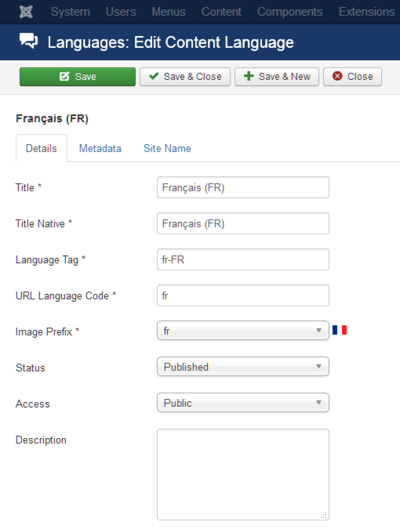Configurar un sitio multilingüe - Crear un lenguaje de contenido
From Joomla! Documentation
Tutorial
How to setup a Multilingual Joomla! Site
How to setup a Multilingual Joomla! Site
Articles in this Series
- Introduction
- Step 1: Installing a new language
- Step 2: Creating a Content Language
- Step 3: Enabling the Language Plugins
- Step 4: Adding Multilingual Content
- Step 5: Creating Menus for the Multilingual Content
- Step 6: Duplicate your Template for each Language
- Step 7: Adding a Language Switcher
- Step 8: Exploring the multilingual site
Joomla! allows you to create easily a multilingual website, without having to install any third party extension. In this tutorial, you’ll find a complete walkthrough of the steps involved in creating a multilingual Joomla! site.
Step 2 - Creating a Content Language
The next step is to create a Content Language. Although you’ve already installed a second language pack (in this example the French language pack), you still need to add the appropriate details for this language. To do this, you need to add what Joomla! calls a Content Language. It's a bit like a "language profile", containing all the details needed by Joomla! to be able to use either the English or the French language as "switchable" content languages.

- In the Language Manager screen, click on Content Languages in the left sidebar. At this step, there is just one Content Language available: English.
- Click the button New.
- In the Edit Content Language screen, add the following details for the new language:
- Title: Français (FR). This is the language name as it will appear in the lists.
- Title Native: Français (FR). This the original language name. This title will be displayed in the Language Manager, in the list of Content Languages.
- Language Tag: fr-FR. This should be the exact prefix used for the language installed (or to be installed). It consists of the language code (in lowercase), an hyphen and the country code (in uppercase). If you’re not sure about the Language Tag, you can find it next to the language name in the list of installed site languages in the Language Manager.
- URL Language Code: fr. This is the code Joomla! will append to the site URLs. In our example, the output will be:
www.example.com/fr/if SEF is activated (if SEF is disabled, the output will be&lang=fr). Each installed language must have a unique code. - Image Prefix: select fr. Joomla! uses this code to display a country flag image enabling the visitor to select a site language. When fr is selected, Joomla! will display the flag image fr.gif located in the folder media/mod_languages/images/.
- Status: this should be set to Published.
- Access: this should be set to Public.
- Click Save & Close. The Content Language profile is now ready!
CHUNCK